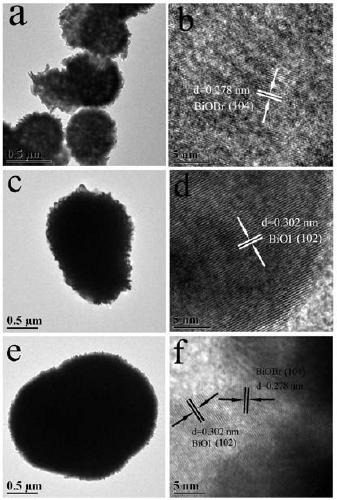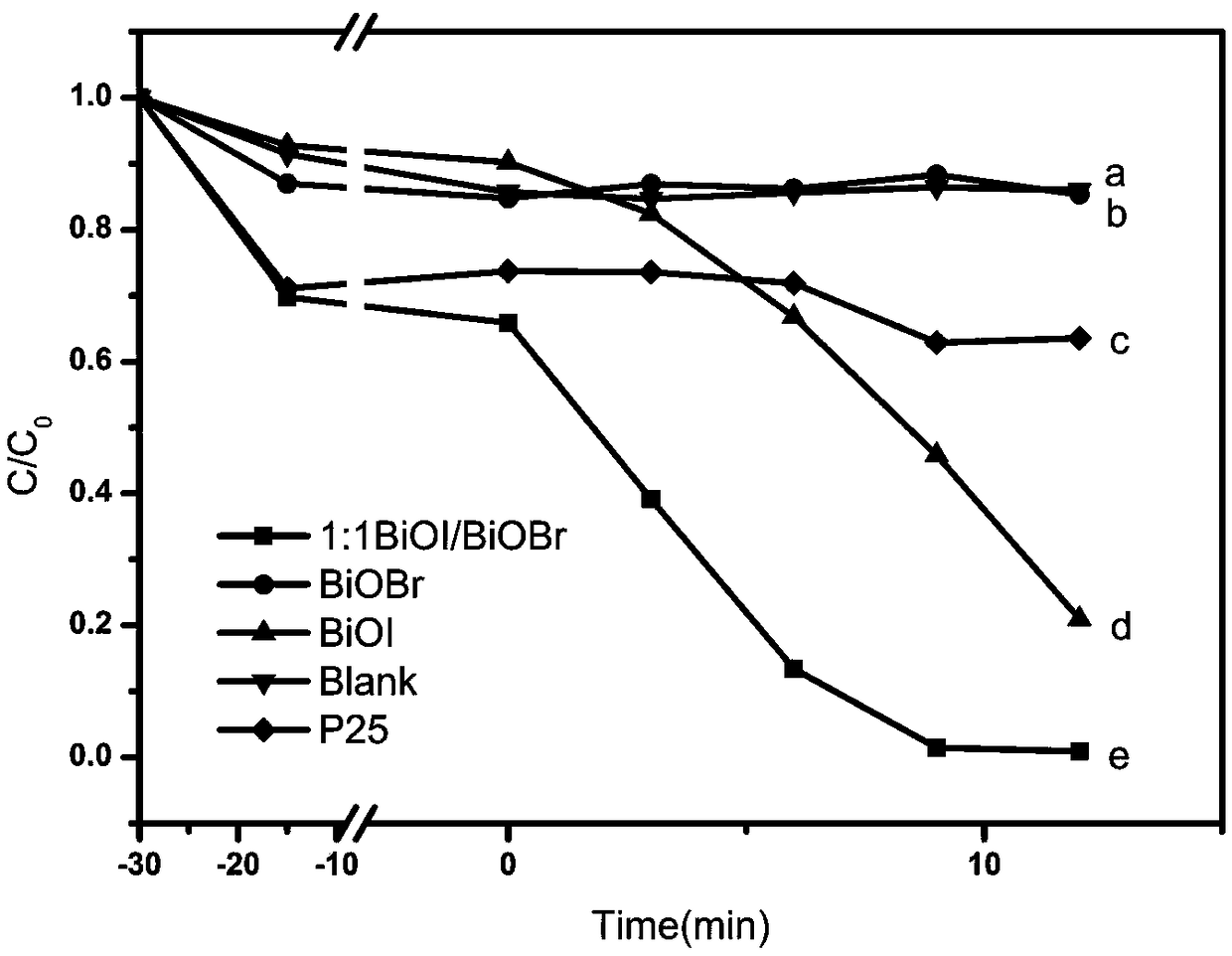Preparation method and application of bismuth oxyiodide/bismuth oxychloride heterojunction photocatalyst
A photocatalyst and heterojunction technology, applied in the direction of catalyst activation/preparation, physical/chemical process catalysts, chemical instruments and methods, etc., can solve the problem of low photocatalytic activity, disadvantageous effective separation of photogenerated electrons and holes, and low quantum efficiency. and other problems, to achieve the effect of overcoming low photocatalytic activity, high visible light catalytic activity, and high photocatalytic activity
- Summary
- Abstract
- Description
- Claims
- Application Information
AI Technical Summary
Problems solved by technology
Method used
Image
Examples
Embodiment 1
[0041] (1) Dissolve 4 mmol of bismuth salt in 10 ml of ethylene glycol + 30 ml of water, and stir magnetically for 30 min at room temperature;
[0042] (2) Dissolve 2 mmol of bromine source in 10 ml of ethylene glycol, stir magnetically at room temperature for 10 min, then add dropwise to the above solution, and continue stirring for 20 min;
[0043] (3) Dissolve 2 mmol of iodine source in 10 ml of ethylene glycol, stir magnetically at room temperature for 10 min, then add dropwise to the above solution, and continue stirring for 1 h;
[0044] (4) The yellow solid was separated by centrifugation, washed three times with deionized water and absolute ethanol respectively, and dried in an oven at 60°C;
[0045] (5) Take out the dried solid and grind it with an agate mortar to obtain dry BiOI / BiOBr powder.
[0046] 5 mg BiOI / BiOBr photocatalyst was added to the EE2 solution with a concentration of 3 mg / L, and after dark reaction for 30 min, the photocatalytic degradation was carr...
Embodiment 2
[0048] (1) Dissolve 4 mmol of bismuth salt in 10 ml of ethylene glycol + 60 ml of water, and stir magnetically for 30 min at room temperature;
[0049] (2) Dissolve 2 mmol of bromine source in 10 ml of ethylene glycol, stir magnetically at room temperature for 10 min, then add dropwise to the above solution, and continue stirring for 20 min;
[0050] (3) Dissolve 2 mmol of iodine source in 10 ml of ethylene glycol, stir magnetically at room temperature for 10 min, then add dropwise to the above solution, and continue stirring for 1 h;
[0051] (4) The yellow solid was separated by centrifugation, washed three times with deionized water and absolute ethanol respectively, and dried in an oven at 60°C;
[0052] (5) Take out the dried solid and grind it with an agate mortar to obtain dry BiOI / BiOBr powder.
[0053] 5 mg BiOI / BiOBr photocatalyst was added to the MO solution with a concentration of 3 mg / L, and after dark reaction for 30 min, the photocatalytic degradation was carri...
Embodiment 3
[0055] (1) Dissolve 4 mmol of bismuth salt in 20 ml of ethylene glycol + 30 ml of water, and stir magnetically for 30 min at room temperature;
[0056] (2) Dissolve 2 mmol of bromine source in 20 ml of ethylene glycol, stir magnetically at room temperature for 10 min, then add dropwise to the above solution, and continue stirring for 20 min;
[0057] (3) Dissolve 2 mmol of iodine source in 20 ml of ethylene glycol, stir magnetically at room temperature for 10 min, then add dropwise to the above solution, and continue stirring for 1 h;
[0058] (4) The yellow solid was separated by centrifugation, washed three times with deionized water and absolute ethanol respectively, and dried in an oven at 60°C;
[0059] (5) Take out the dried solid and grind it with an agate mortar to obtain dry BiOI / BiOBr powder.
[0060] 5 mg BiOI / BiOBr photocatalyst was added to the E2 solution with a concentration of 3 mg / L, and after dark reaction for 30 min, the photocatalytic degradation was carri...
PUM
| Property | Measurement | Unit |
|---|---|---|
| clearance rate | aaaaa | aaaaa |
| clearance rate | aaaaa | aaaaa |
Abstract
Description
Claims
Application Information
 Login to View More
Login to View More - R&D
- Intellectual Property
- Life Sciences
- Materials
- Tech Scout
- Unparalleled Data Quality
- Higher Quality Content
- 60% Fewer Hallucinations
Browse by: Latest US Patents, China's latest patents, Technical Efficacy Thesaurus, Application Domain, Technology Topic, Popular Technical Reports.
© 2025 PatSnap. All rights reserved.Legal|Privacy policy|Modern Slavery Act Transparency Statement|Sitemap|About US| Contact US: help@patsnap.com



